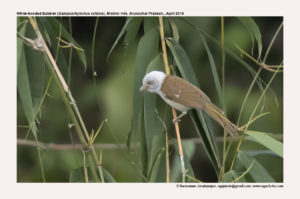
White-hooded Babbler Gampsorhynchus rufulus
Etymology:
-
- Gampsorhynchus : Greek word gampsos -curved; rhunkhos- bill
- Rufulus: Latin word for “ Reddish”
Vernacular Names: Cachar: Daophlantu-tiba, Lepcha: Chongto-phep-pho
Distribution in India: Resident of Eastern Himalayas and North East hills in India.
Description:
Size of 23–24 cm; Wt. of 37–49 g. It is a sleek, longish-tailed buff-brown babbler with
white head and underparts and rather sturdy hook-tipped bill; feathers of forehead and chin upright
and bristly, rictal bristles are long and black. The head and breast are white, shading to buff on flanks
and belly, thighs and vent. The upperparts are sandy brown, upperwing is slightly darker with white
median wing-coverts and some lesser coverts forming variably visible white shoulder patch, tail is
similar to wing, with narrow buffy tips. The iris is yellow to orange-straw; bill is variable from pinkish
to dark horn; legs are yellowish or flesh-coloured. Both the sexes are similar. The juvenile has rufous
head and breast side, shading into buff of underparts.
Habitat : It is found in bamboo and middle storey of broadleaf evergreen forest, secondary growth, scrub, bushes and long grass at edge of forest. It is found up to 1200 m.
Food habits: It eats invertebrates. It forages above ground, mainly in bamboo canopy. It is gregarious
and noisy, often in association with other species, including other babblers, particularly Red-billed
scimitar babbler and Greater Rufous-headed Parrotbill.
Breeding habits: They breed in Apr–Aug in India. The nest is a shallow, flimsy saucer, made of dead
leaves, a few small twigs, roots, lichen and a little moss, untidily bound together with cobwebs, roots
and tendrils, lined with fine grass, rootlets and tendrils, placed above ground in bush. They lay a
clutch of 3–4 eggs.